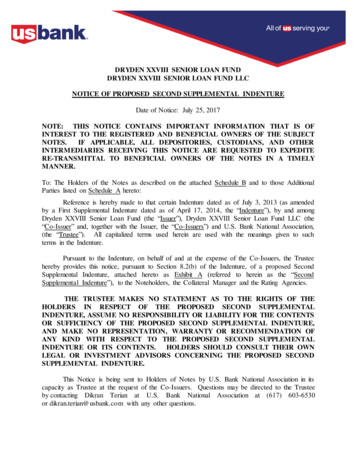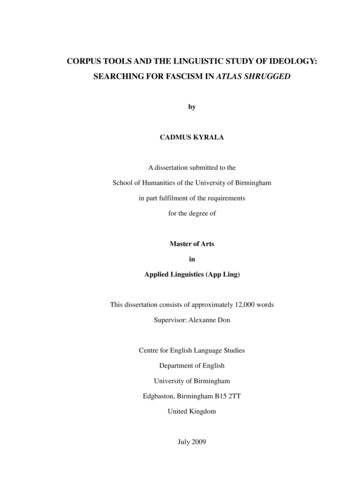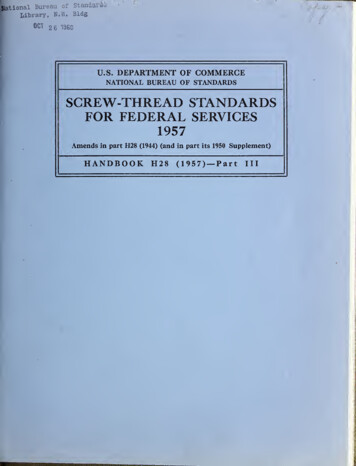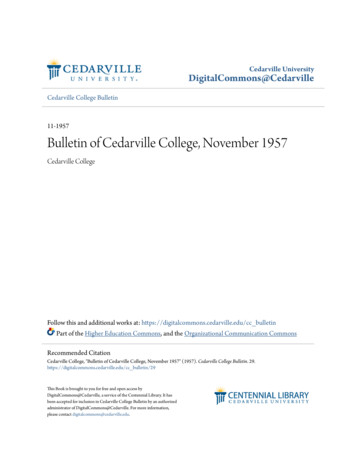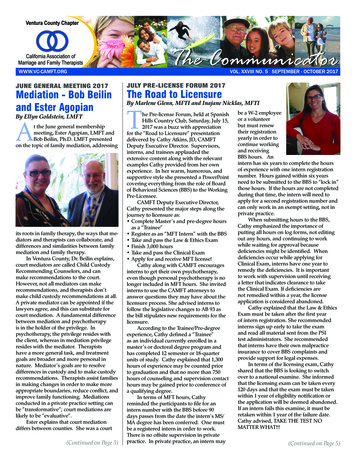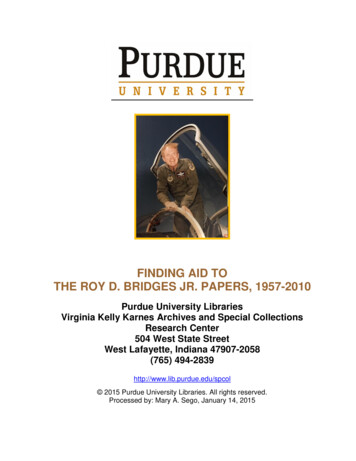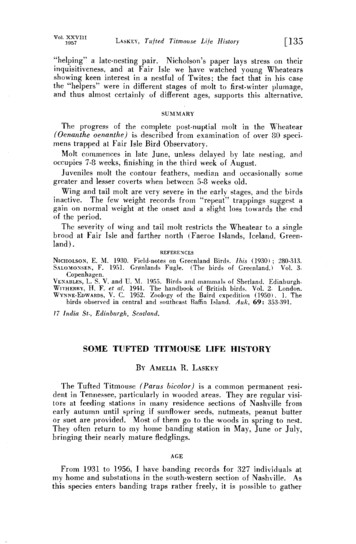
Transcription
Vol.XXVIII1957LASKEY,Tu/tedTitmouseLi/e History[135"helping"a late-nestingpair. Ni,cholson'spaperlaysstresson theirinquisitiveness,and at Fair Isle we have watchedyoungWheatearsshowingkeen interestin a nestfulof Twites; the fact that in his casethe"helpers"werein differentstagesof moltto first-winterplumage,and thus almostcertainlyof differentages,supportsthis alternative.SUMMARYThe progressof the completepost-nuptialmolt in the Wheatear(Oenantheoenanthe)is describedfromexaminationof over80 specimenstrappedat Fair Isle Bird Observatory.Molt commencesin late June,unlessdelayedby late nesting,andoccupies7-8 weeks,finishingin the third weekof August.Juvenilesmolt the contour feathers,median and occasionallysomegreater and lessercovertswhen between5-8 weeksold.Wingandtail moltareveryseverein theearlystages,andthebirdsinactive. The few weightrecordsfrom "repeat"trappingssuggestagain on normal weightat the onsetand a slightlosstowardsthe endof the period.The severityof wing and tail molt restrictsthe Wheatearto a singlebrood at Fair Isle and farther north (Faeroe Islands, Iceland. Greenland).REFERENCESNICHOLSON,E. M. 1930. Field-notes on Greenland Birds. Ibis (19301: 280-313.SaLO aONS ;N,F. 1951. Grinlands Fugle. (The birds of Greenland.) Vol. 3.Copenhagen.V ;NaBLZS,L. S. V. and U. M. 1955. Birds and .mammalsof Shetland. Edinburgh.WITHERBY, H. F. et al. 1941. The handbook ,of 'British birds. Vol. 2. London.WYNNE-EDWARDS,V. C. 1952. Zool,ogyof the Baird expedition (19501. 1. Thebirds observedin central and southeastBaffin Island. Auk, 69: 353-391.17 India St., Edinburgh, Scotland.SOMETUFTEDTITMOUSELIFEHISTORYBY AMELIA Pt. LASKEYThe Tufted Titmouse(Parus bicolor) is a commonpermanentresidentin Tennessee,particularlyin woodedareas.Theyare regularvisitors at feeding stationsin many residencesectionsof Nashvillefromearly autumnuntil springif sunflowerseeds,nutmeats,peanutbutteror suetare pro.vialed.Mostof themgo to the,woodsin springto nest.They oftenreturn to my homebandingstationin May, Juneor July,bringingtheir nearlymaturefledglings.AGEFrom 1931 to 1956, I have.bandingrecordsfor 327 individualsatlny homeand substationsin the south-westernsectionof Nashville. Asthis speciesentersbandingtrapsratherfreely,it is possi'bleto gather
136]LASKEY,TuftedTitmouseLife HistoryBird-BandingJt,iydata on their life span. At the presenttime, 309 individuals,the number banded to the end of 1954, could have remained at the station for2 years or more. I find that 23 Tufted Titmice did so (8 percent); 13remainedabout2 years,7 for 3 years,onefor 41//, ,years,3 for 5 years,and one for 6 years,3 months. The exact age for the latter is known.He was bandedNo. 42-109431 as a nestling,hatchedApril 21 19,1.8,andwaslast seenon July 19. 1954. Middleton11949) in Pennsylvaniareporteda TuftedTitmousebandedon January7, 1939 whichremainedto nest in one of his boxes each year and was capturedfor the lasttime on September15, 1945 at 7 1/3 yearsof age.HABITSRat,herrarely one of the residentswill remain at my hometo nestin a box and occasionallya pair hasoccupiedoneof the boxesplacedinWarner Parks for Bluebirds(Sialia sialis) or attemptedto use a tincylindernewspaperbox on the roadside. Usually a natural cavity in atree or fence-postis preferred. Becausethesenatural cavitiesare ofteninaccessiblefor watching,thereis a paucityof publisheddata on thenestingof this species. Therefore I am summarizingsomegeneralobservationson behaviorand nestingin the Nashvillearea. In addition, data were obtainedfrom 93 hours of watchingthe incubationand nestlingperiods of an entirely successfulbrood of sevenyoung,one of them being the previouslymentionedNo. 42-109431, called"Lefty" becausehe was bandedon the left tarsus.In the non-breedingseason.Tufted Titmice are social, flying andfeedingamicablytogetherin twosomes,in groupsand in associationwith the closely related Carolina Chickadee (Parus carolinensis).Myrecords of distinctivelymarkedindividualsindicate that the twosomes nay be a matedpair, but not always. They may be birds hatchedtheprevious summer, probably of the same brood, or a parent and ayoungster. The smallgro.upsmay be a family or a brood. I have notseen large groups. One color-bandedpair and their son remainedtogether for the entire winter. At times mother and son came to thefeedertogether. Van Tyne (1948) ,hadtwo marked young cometohis feedingshelfwith their parentsunti} November8, 1942 and afterthat date, one young continuedto come with them until January 10,1943.Often when oneTufted Titmousewastrapped,a companionremainednearby,usinga raspingvocalsound,whilethe entrappedbird wasbeinghandled,accompanyingit whenreleased.Gillespie11930,p. 122) mentionsthis ha,bit.On April 21, when nestingmusthavebeenin progress,the actionsof one of a pair, in a threateningtype of posture.,suggesteda so t of distraction display. As usual this bird used the raspingnotesas I handl'edt,hemate, but insteadof flying off with it, this oneflew within ten feet of me, faced me on he ground and displayedbycrouchingwith spread wings, thrusting head forward and rasping.Odum i1941, p. 531) describesa somewhatsimil.ar,but more exaggerated display by the Black-cappedChickadee(Parus atricapillus)when he caughttheir newly-fledgedyoung.
Vol.XXS]III1957La. KE ,,Tit.iredTitmouseLi./eHistor)'[1 37In winterTufted Titmice frequentlystorefood or attemptto do so.In October, 1955, one tucked a shelled sunflowerseed into a creviceof the bark of a silvermapletree: a squirrelimmediatelyattemptedto extractit. In December,1940, one searchedamongthe Englishivvvinesona treetrunkfor a pl.aceto hidetheseedit wascarrying.January,1944, onegatheredbits of bread,flewto a clumpof plants,ho,ppedall aroundthe clump,lookinginto it, but finally droppedthefoodon thefrozenground. On anotheroccasion,I watcheda CarolinaChickadeehidinghulledsunflowerseedsin tree-barkcrevices,but eachtime that the chickadee went after another seed, a Tufted Titmousehelpeditselfto the storedkernel. In Kentucky,Helenand Paul Owen(1956), report Tufted Titmice pushingsunflowerseedsdeeplyintothe sodon October12, but did not seethem attemptingto recoverthemlater.BATHINGI have not seena Tufted Titmousebatheexceptin spray from thegardenhose. In July, 1954, four fledglings,still beingfed, but nearindependence,had a great frolic bathingin the sprayin the garden,but were not joined by their parents.On June22, 1948, a hot, humid day, an immaturetitmouse,abouttwo monthsold,sprawledon the houseroof for a brief tmicesinglengthyformlesssongsas do manyotherjuvenil.ebirds. On September10, 1944,I heardonesingingthattype whichI wouldnot have recognizedexceptfor the occasionalpetonotesinterspersedwithin the medley. On July 19, 1954 when Leftyandhis matebroughttheir g,but did not useany petonotes.After a periodof silenceor infrequentsongin winter,the voiceofthe TuftedTitmouseis usuallyheardby mid-Januaryin loudpeto,peto,peto,or peo,peo,peoor a rapidlyutteredp, p, p, mostpersistentl'ybymale whencallingfor a mate. By Februaryand March, a sibilantsweet, sweet or see, see or see-bee(similar to a Carolina Chickadeesong) is usedalso. Thesesibilantnotesare heardmainly whena pairis togethersometimesas theyfeedtogetheror whenthe malecallshismate to give her food that he hol.ds in his bill. The male of the 1948nestingpair usedthe loud petofrom a distanceto call his incubatingmate from the nest for food. If she had not joined him, he camecloser to the nest and used the soft sibilant notes to call her off.Afterthe younghatchedwhenhe no longerfed the female,he announcedhisarrival in the vicinityof the nestwith a harshraspingcall, occasionall'ywith a peto note.The courtshipfeeding behavior starts in March before incubation,but is more commonlyobservedin April during nest-building,egglaying and incubation.The female assumesthe beggingpostureof ajuvenileto receivethe food, crouchingand quivering herwings,usingsoft sibilant notes. Hinde ,1952, pp. 90-96) describesthis "wingshivering"displayfor severalParidaein Europeas a part of courtshipfeedingand copul.atory behavior. The pair that nestednear our house
ngquiveredtheir wingsas they met near the nest as eachcarriedlarvaefor their nestlings. The femaledid this muchoftenerthan the male,but on April 19, two daysbeforethe eggsbeganto hatch,the malequiveredhis wingsbeforefeedinghis ma.te. He did this again whenthey met on April 21 and April 25 as they both approachedthe nestwith foodfor thenestlings.On April 28 whenthe youngweresix andsevendaysold, thepair quiveredwingsas theymet. Throughoutthenestl'ingperiod, the female was seenquiveringher wings many timeswhenshesawher mate,but he neverpassedany foodto her after theyoungwerehatched. O.dum1,1941,pp. 526-527) saysthat onl.yrarelyhashe seenthemaleBlack,cappedChickadeefeedthe femaleawayfromthe nestafter .theyounghavehatched;he ignoresher and feedstheyoung,but wing-flutteringmay still take place.Sometimesear!yin springthe intenti.onof the maleTuftedTitmouseto feedthe femaleis not consum,mated.On March 10, 1950. Lefty andhismatewereperchedon a feeder,whenthe fatherof thistwo-year-oldmalearrived. The femaleflew. Lefty flewat his father,Blue,drivinghim away t I never saw Blue again). Lefty then returnedto the feeding shelf,picked up a seed,calling see, see many times. The otherbird did not reappearsohe flewto anotherperchto eatthe seedhimself.AnotherMarch feedingattemptwas thwartedby an interruption:themalecalledwith a seedin his bill, but the femaledid not appear. OnMarch 26, 1955, one fed his mate on the groundand while per.chedintrees. Brackbill (1949) observedcourtshi,pfeedingin Maryland before the incubationpatchhad devel.oped.During the first part of the incubationperiod, female Red missedseveralfeedingsbroughtby her mate, Blue, to the vicinity of the nst.Sometimesshe was absent; other times she did not respondto hispeto or sibilant calls and remainedon the nest. Previous to the 8thday of incubation,! did not seehim g.oto the nest-boxwith food, buton April 16th, he beganto deliverit to her at the entranceif she didnot leavethe nestto meet him on a nearbytwig.NESTINGBetween 1939 and 1955, I have obtained some data on two nestsinnatural cavities,six in nest-boxesand one in a tin newspaperbox atthe roadside. Cl,utchesconsistedof 5 to 7 eggs.Many booksl includingBent, 1946) statethat the Tufted Titmouselays 4 to 8 eggs; Butlert1897, p. 1134) states5-6, sometimesas many as 9. The only citedrecord of 8, found in available literature, is one in the Cleveland,Ohioregion. Williams 11950,p. 102) states:"June27, family of 8 leavingthe nest." For the Plain Titmouse (Baeo!ophusinornatus), Price11936) records3 to 9 eggsin 62 clutcheslaid in nest-boxesin California, with 7 egg setspredominating117 nests). My findingsin Nashville agree with those of Wayne for the Tufted Titmouse in SouthCarolinai1910, p. 194) whofound5 to 7 eggsin a set. In Nashville,I found3 setsof 5 eggs;3 setsof 6 eggs,plusonefoundwith 6 yo.ungin a naturalcavity; 3 setsof 7 eggs. One set of 5 eggsall hatched,butthe youngdisappearedby the 13thday,the ot.hertwo setsproduced3 fledglingseach. One of the 6-eggsetsproduced5 y,oung,the one
Vol.XXVIII1957LASKEY,Tu/tedTitmouseLi/e History[139in the newspaperbox wasdeserted,andthe onein a naturalcavitywasnot followedafter hatching. Of the 7-eggsets,one was taken by apredator,one set was sterile and was collectedon the 18th day whenthe femalewasstill incurbating.The third setwas entirelysuccessful.From the 7 nestswhereall data are known,18 youngfled gedfrom 43eggs (42 percentsuccess). Middleton (1949) reportsthat No. 39126650, the old bird that nestedfor 7 years in a box at his home inPennsylvania,with its matespro.duced47 young. He doesnot statethe numberof eggslaid, but reportsall nestssuccessfulwith 3 to 7youngin a brood. This bird wasmated with No. 39-126609in 194041-42 and for the next three years with No. 40-137944. In 1941 thereweretwo broods(5 and 3) and in 1945, two broods(7 and 5 young).No knownsecondbroodsare on recordin Nashville. Wayne (1910)statesthat the Tufted Titmouseis singlebroodedin SouthCarolina.The nestsbuilt in boxeswereusuallyabout5 feet from the ground,one was 71/.', feet. Thosein natural.cavitieswere 51 2to 7 feet from theground. H. C. Monk has given me sc medata on nestsin naturalcavitiesin the Nashvilleregion; onein a gumtree was18 inchesaboveground,anotherin a hackberrytree was20 feet. On April 15, it held4 fresh eggswhich were cold to the touchthat night about 8:00 p.m.alth u.ghthe bird was in the cavity and attackedhis hand. Apparentlythe set was incompleteand incu'bationhad n.ot started.'In additionto greenmoss,grass,leaves,vegetalmatter and stringusedin t,hebody of the nest,I have oftenfound snakeskin or scales.Wayne t1910) mentionsthe presence,of snakeskinsin the nestshefound in South Carolina. He also descri,bes a very unusualnest builtin Spanishmossseenon April 23, but the followingday after a storm,he foundthe 5 eggs,onthe ground. The femalebeganto build in thesamemassof mossalthoughthe male appearedto be trying to interesther in a nearbycavityby flyingto it and callingto her. By May 3, shehad completedthe secondnest and laid 3 eggs,but the foil,owing day,that nest also was blown down.Butler i1897, p. 1136) citesa record of anotherunn.sualnest nearCincinnati,Ohio in May. Six nearly hatchedeggswere found in ah,ole excavatedin the sideof an old, roughnestof a large bird in thetop of a tall sapling.During egg-laying,it is customaryfor the femaleTufted Titmouse,like the Carolina Chickadee,to cover the incompleteset with nestlining materialwhensheleavesthe nest.Nestsare usually1.inedwithsoft fibers or mammalhair, sometimessheepwool. This habit tendsto protectthe eggsas it givesthe i.mpressionof an incompletenest.I haveneverfoundthe eggsof either species.coveredafter ineu,bationhas started.In 1948, the residentpair .ofTufted Titmicebuilt in a box fastenedto a tree trunk about7« feet from the ground,sometwentyfeet fromour windows. Their nestwas a few feet from an ivy-coveredhackberrytree w,herea pair of Blue Jays (Cyanocittacristatayhad their nest.Betweenthe two nestswasa smallelm tree whichwas usedas a perchby the Blue Jays and the Tufted Titmice.The male had been 'bandedas an ilnmature (first year) bird onJuly29, 1947,called"Blue"from the plasticbandhe wore. His mate,
]140]ßLASKEY,Tu/tedTitmo tseLiieHistoryJ,11yBird-Banding"Red," wasbandedon March 25, 194.8. Nest-buildingwasfirst noticedon March 24 when a layer of green nosscoveredthe bottom of thebox. Upon the thick layer of mosswasa layer of dry leaf fragments.The depressionwas lined with 1 /2 inchesof soft material, includingvegetalfibers,narrow stripsof pa.per,rabbit and opossumhair. I wasunableto wat.chcloselyenoughto learn which of this pair carried thenest material, .but among other Paridae, the female builds the nest{Odum,1942, p. 524; Hinde, 1952, p. 7 . The 7 eggswere laid fromApril 2 to 8 and werecoveredeachday with nestmaterialuntil incubation startedat the completionof the set. The femalealoneincubated.I did not go to her nestwhileshewasin the box.but with other'incubating Tuf.ted Titmice, I foundseveralthat wouldnot leavethe nestwhenI openedthe top. At leastthree incubatingbirds allowedme to liftthemfrom their eggs,bandthemand repl'acethem,onthe eggs. Mostof the Tufted Titmice that I observednesting,hissed,sputteredandlungedforward as I lookedinto the nestor put my hand near the incubating.bird. Oneof thembeganto peckthe sideof theb,ox afterhissing.I havenotedthis hissingand lungingbehaviorin the Carolina Chickadeewhichin my experienceis even noreexplosivein her demonstration.Observers have found this behavior in other Paridae. Hinde II952)and Sibley 11955) discussthis habit which in many ways ap.pearsimitativeof the actionsof a snake. Sibley observeda Plain Titmousea numberof timesand says:"The entirepatternof swayingmovementand hissingsoundwas stronglysuggestiveof a snakeand undeniablystartling." "It is not difficultto believethat potentialpredatorswouldfrequentlybe frightenedby this activity."INCUBATIONAlthoughincubationof the 1948neststartedon April 8, I wasunableto makelengthyobservationsuntil the third clay.April 11. The femalecontinuedto bring bits of fiber or mammal hair to add to the nestlining at leastonceduringeachobservationperioduntil April 18, the10th day of incu.bation.As her periodson the nestwerelong and I wasunableto watchcontinuously,nayrecordsshowa largenumberof incompleteperiods. nostof which are omittedin the followingtabulationof attentiveand inattentive periods. The attentiveperiods ion the nest) range from 18to 73 minutes,with the shorterperiodsoccurringin the latter-part ofthe incubation. The averageattentiveperiodwas39 minutes.The periods off the nest range from 3 to 51 minutes. This oneunu.suallylong absenceof 51 minutesoccurredon April. 12 whentheday was unusuallywarm with a mean temperatureof 78 degrees,20degreesabovenormal. The averagefor inattentiveperiodswas 18minutes.In the followinglist, the periodsin parenthesisrepresentthoseoffthe nest: April 11, fp.m.} q- 61(19}; April' 12 (p. n.), q- 66151):April 13, (32)42120)50t3);April 14, (7)40112)73, 52(19144 10):April 16, (13)66(18)55(25)32117); April 17, 28(3)30. 17117)36 16); April 18, i19)27110)26(23)29124}: April 19, 125)3g124t18(31). For the Black-cappedChickadee,Odum '1941,p. 523)
Vol.1957XXVIIILA. E¾,TttftedTitmouseLifeHistoryßfound the average attentive period to be 24 minutes and averageinattentiveperiod 7.8 minutes.NESTLINGPERIODOn April 21, the 13th day of incubation. young were hatching.At 5:35 a.m.C.S.T.5 had hatched.As I looked into the nest-box. thefemalesat on the nestwith half an egg shell.in her bill. She gave ahissingnote and lungedtoward me. throwingthe egg shellto the nestrim.She flew off'the nest and soon afterwardreturned with a larva inher bill. I was still'near the nest; she hoppedabout in a near-bytreeas if shy of me, then swallowedthe food herself.I went indoorsand the pair continuedto bring food to the young.As the male had been going to the nest with food for the female. hewas doubtlesswell aware when the young were hatching. Sometimebetween10:30 a.m. and 4:{)0 p.m., tile sixth egg hatched. The femalewent into the box at 5:23 p.m. 63 minutesbeforesunset. The seventhegg hatchedstonetimebeforethe next day.She broodedmuch of that morning, but after that, I failed to findher on the nestat any time duringthe day until towardeveningwhenshewenton for the night. After May 4, whenthe youngwere12 and13 days old, sheceasednight brooding,leavingthe young unattendedfor the last four nights in the nest. Table 1 showswhen tile femalewent into the nest to brood:April 21MayTemp.72Type of dayPartly cloudyMin. before sunset632481clear262728788367cloudymostly fairpartly cloudy2728262969clear25788067cloudy howery howery915241345Three days before the young fledged,the male fed bread at leasttwice, and pecanlilts wheneverhe couldfind them on the feedingshelf.When the male discontinuedpassingfood to the female after theyounghatched,therewasa definitechangein his vo.calnotes. Insteadof the loud peto from a distanceor the sibilant soft note when nearthe nest,.heuseda harshraspingnote mostof the time as he perchedon a twig a few feet fr.om the nest before deliveringthe food to theyoung. He becamemoreexcitable,sometimesraspingfor severalminutesat a time. This wasparticul.arlynoticeablewhen he met the BlueJays; previouslyhe had usuallywatchedthem in silence. He had resentedthe presenceof a pair of Cardinals(Richmondenacardinalis)during the incubationperiod. flying at them. This 'belligerencecontinued; he flew at a Myrtle Warbler (De.droica coronata)that he metnear the nest; he scoldedsquirrels,a chipmunk,a Purple Grackle(Quiscalusquiscula) and me. May 1, he perchednear a male Cow-bird (Molothrusater), merelywatchinghim. On May 5, he raspedexcitedlyfor long intervalsat a chipmunkon the ground,then he beat
142]LASKEY,Tu/tedTitmouseLi/e HistoryBira- anaingJulythe larva that he held in his bill againsta branch. In the many timesthat ! had watchedhim approachwith food, I had neverseenhim dothis beforeand tho,u,ghtthat it might be a substituteactivityin ventinguponthe larva the fury that he felt towardthe chipmunk.On April 25, the female'TuftedTitmouseflew hissingat a Starling(Sturnusvulgaris),but sheusuallyignoredotherbirds.The rate of feedingshowedan increasefrom 7 per hour on April 23to an averageof 24 per 'houron May 8, the last day of nest-life. Anaccelerationin the rate of feedingwasalsonotedfrom the mid or latemorninghours into the afternoon. The slowestrates occurredinearly morningand late in the day. Althoughit was not possibletoidentifyeachbird as it broughtfood beca.usethey often arrived anddepartedso swiftly, the male definitelyassumedthe greater shareofprovidingfood.On four morningsduring the nestlingperiod, I learnedwhen thefemaleleft t.henest: April 28 at sunrise;April. 30 at 5 minutesaftersunrise;May ! at 7 minutesafter and May 5 at 10 minutesafter sunrise.First feedingsof the morning'were'broughton threemorningsbetweenApril 26 and May 5 bythe male at 6 to 9 minutesafter sunriseand onMay 6 by the pair at 12 minutesafter sunrise,the femaledeliveringherlarva first (shehad not broodedthe previousnight).Final feedingsfor the day were notedon 12 evenings. On April24 l young 2 and 3 days old) the male fed 9 min;utesbefore sunset;on April 28, the female broughta meal as she went into the box tobroodfor the night at 28 minutesbeforesunset. Ten minuteslater, themale arrived with food, looked into the box, then flew with the larvato a near-bytree, swallowedit, wipedhis bill and flew. On six eveningsthereafter i to May 4) the male b ,oughtthe final meals at 30, 14, 22,17, 32, 41 minutesbeforesunset. On the next four evenings,t.he[emaledid not brood. She and her mate broughtthe late mealson alternateß eveningsat 30, 29, 15 and 44 minutesbeforesunset. During the Maynestlingperiod, there was .considera.blecloudinessand light s.howersalmostdaily.Wight (1934) in 'Cha.ttanooga,Tennessee,reportedthat after a broodwasraisedin oneof his nest-boxes,the parents(apparentlyunmarkedfor identification) returnedfor a secondnestingand were assistedinthe feeding of this secondbrood by one and sometimestwo othersw,hich he belived were youngof the first brood.On April 30, ! bandedthe sevennestlingsthen 8-9 daysold. Theprimaries and rectriceswere unsheathedabout 3 millimeters;eyeswerenot opento full roundness.All werequiet when.handledanddidnot cower. On May 1, .their voicescould be heard at somedistance.By May 5, they crouchedwith lowered heads as ! looked into thenest. They werewell leatheredwith tails about7 min. 1.ong.They hadbecomevery vociferouswhenthe parentsarrived with food. On thisdate, I watched the nest for 3 / hours (7:00 to 9:00 a.m., 11:30 to12:30, 5:30 to 6:00 p.m.) when .theparentsbrought an averageof15 mealsper hour. Mrs. Nice (1931, p. 132) watcheda broodof 5well-leathered Tufted Titmice in O.klahomaon June 6, 1926 when 18mealswere fed from 2:00 to 4:00 p.m. T.he female brooded3 and 8
Vol.XXV.III1957L ,,I EY,TujtedTitmouseLije Histor),[ ] 43minutes. The foil.owing day from 10:40 to 12:10, they received 7meals in 11/2 hours and she brooded 8 and 15 minutes.Duringmy watchperiods,themalewasmoreactivein nestsanitation;,he removed 14 sacs and the female 7.On May 8, a nestlingo.ftenpokedits headout of the entrance.usingthe sibilantsu-wetor su-wet-tetnotes;the adultscalledpeto offenerfrom a distance.They sometimescameto the ,boxwithoutfood. It wasevidentthat it was abouttime for the nestlingsto leave,but all of thatday theyhesitatedand the sevenwerestill.in the nestwhennight came.But they were off and away before 6 o'clockthe followingmorningwithoutmy seeingthemleave. They were 17 to 18 daysof age.WEIGHTSAfter a 9-day absence,the family returnedon May 18. On June 1,two of the fledglingsentereda bandingtrap. One weighed20 grams,the other 20.6 grams. On July 1, one of the .brood,Lefty, enteredatrap. He weighed22.4 grams. On September1, he and his motherwere both in traps at 8:00 a.m. He weighed23.3 grams and sheweighed19.1 grams.FourteenTuftedTitmice,knownto be at leasta year old, havebeenweighedat my station. They averaged20.5 grams, ranging from18.6 to 22.3 grams.LEFTY,HISMATESAND YOUNGLefty followedthe usualpatternof the speciesat my station. In April,1949, he was feeding"Orange." a newcomerbandedthat month. Hehad spentthe winterwith hisparents,BlueandRed, but Red, his mother,had disappearedin early spring of 1949. Blue soonobtaineda newmate, "Green." Both pairs left, doubtlessto nest elsewhere.In September,1949,Lefty, Blueand Greenreturned,but the latter disappearedsoon afterward. Lefty and Blue frequentedthe banding station allwinter, Blue disappearedin March and Lefty went away later thatspring11950)butreturnedJuly7 witha f ll-grownfledglingthatassociatedwith him through that autumn and the winter of 1950-51.Lefty wasoftenseenin springof 1951,but his matewasneveridentifiedas any of the residentsor visitorsat my station. On June 21. 1931,Lefty was feedinga large fledglingwhich was soonbandedand remaineduntil the latter part of January 1952. After March of 1952,Lefty was not seenuntil November,1952, al.thougha brood of youngappearedin June. He againspentthe winter at the station 11952-53),left in spring,returningin September,1953, for the winter. In thespring of 1954, his mate was a yearling, banded in July, 1953. Asusual, they disappearedin spring, returningJune 6, both enteringbandingtraps. On July19, 1954,theybroughttheirfour largefledglingswhichwerestill dependent.A few daysafterward,all of the )oung weretrappedand banded.Lefty wasnot seenagain.
'] lySUMMARYThis studyincl.udesobservationson habitsandnestingof the TuftedTitmouse(Parusbicolor),a ,permanentresidentof Nashville.Tennessee,whichusuallynestsin naturalcavitiesin woods,.occasionallyin a nestbox. It frequentsfeedingstationsat homesin the non-breedingseason.From 1931 to 1956, 327 individualswere bandedin my home area.Of these,13 remainedfor 2 years,7 f.or 3 years,one for 41/2years,3 for 5 yearsand one male,bandedas a nestling,for 6 years and3 months. In winter,they are social,associatingin twosomes,in smallgroupsand with CarolinaChickadees.The twosomesmay be a matedpair, aparentandyoung,or two immaturebirds. Smallgroupsmaybe parentsand youngor youngof the previousseason.In fall and winter, Tufted Titmice hide seedsor other food increvicesor in the ground.Juvenileshavea lengthyformlesssongunlikeadultsong;laterin thesummerseason,peto songsare interspersedin the medley. By midJanuaryadultsongs,peto and variationsof it, are commonlyheard.These are used in mate-call.ing. Courtshipfeeding usually starts inMarchpreviousto nest,building.The maleusesa sibilantsee,seecallto the female and she assumesthe begging posture similar to adependentfledglingto solicitor receivethefeeding.In 9 nests,therewere3 setsof 5 eggs,3 setsof 6 eggs,and3 setsof7 eggs.From 7 nestswhereall data are known,18 youngfledgedfrom43 eggs,42 percentsuccessful.A nestin a box at my homewas watchedcl.oselvduring incubationandnestlingperiods.Thesetof7 eggswaslaidApril2 to8. Thefemalealoneincu'bated.Her matebroughtfoodto her to the endof the incttbation period,April 20, but not on or after April 21 when the youngwere hatching.Both parentsfed the nestlings,mainly larvae,but themale assumedthe greatershareof feedingand nestsanitation.The periods on the nest rangedfrom 18 to 73 minutes,averaging39 minutes.The shorterperiodsoccurredin the latter part of the13-14-dayincubationperiod. Inattentiveperiodsrangedfrom 3 to 51minutes,averaging18 minutes.T'hissingl'elongperiodof 51 minutesoccurredon April 12 whenthemeantemperaturewas20 degreesabovenormal.Hatchingof the7 eggsrequiredabout24 hours(April 21-22). Afterthe first day that all werehatched,the femaledid not brood until shewentintothenestfor thenightat 5 to 63 minutesbeforesunset(usuallyabout25 minutes). She did not brood ,onthe last 4 nights.The7 fledglingsleftveryearl.yonMay9 w,hentheywere17 to 18 daysold. After a 9-day absence,they returnedwith their parentsto mybandingstation;later3 of the broodenteredbandingtraps,includingthe one calledLefty.Lefty spentthe winterwith his parentsat my bandingstation. Hismotherdisappearedin early spring,but the followingwinter,Lefty,with his father,wasback. Lefty disappearedeachsprin,gfor nesting,usuallyreturningin summerwith oneor morefledglings.Sometimesoneof his fledglingsspent he winterwith him. Lefty spentsix wintersat ny homebandingstation.
Vol.XXV]II1957WILLIAMS,CaliforniaQuailin ,NewZealand[145ACKNOWLEDGMENTI am indebtedto Dr. MargaretM. Nice for readingof the manuscriptand for helpfulsuggestions.REFERENCESBENT,Aa r UR CLEVELAND.1946. Life Histories of N. A. Jays, Crows, and Titmice.Smithsonian Inst., Washington, D.C.BRACK LL,HERVEY. 1949. Courtship Feeding by the Carolina Chickadee andTufted Titmouse. Auk, 66: 290-292.BUTLFm,A. W. 1897. Birds of Indiana, Dept. of Geology and Natural Resources,Indianapolis.GILLESPIE,lb,lABEL. 1930. Behavior and Local Distribution of Tufted Titmice inWinter and Spring. Bird-Banding, 1: 113-127.HINDE, R. A. 1952. The Behavior of the Great Tit (Parus Major) and SomeOther Related Species. 201 pp. E. J. Brill, Leiden.MIDDLETON,RAYMONDJ. 1949. Tufted Titmouse Nesting Seven Years. BirdBanding, 20: 15-16.NIc ., MARCaR .TM. 1931. Birds of Oklahoma. Univ. of Norman Press, Norman.ODUI I, EUGENEP. 1941. Annual Cycle of the Black-capped Chickadee. Auk,58:314-333.1942. Auk, 59: 499-531.OWEN,HELENANDPAUL. 1956. Tufted Titmice ,BuryingSunflowerSeeds. Ky.Warbler, 32: 62.PRICE,JOHNB. 1936. The Family Relationsof the Plain Titmouse. Condor,38:23-28.SIBLEY,CHARLESG. 1955. BehavioralMi,micry in the Titmice (Paridae) andCertain Other Birds. Wilson Bull., 67:128-132.VA
time on September 15, 1945 at 7 1/3 years of age. HABITS Rat,her rarely one of the residents will remain at my home to nest in a box and occasionally a pair has occupied one of the boxes placed in Warner Parks for Bluebirds (Sialia sialis) or attempted to use a tin cylinder newspaper box on the roadside. Usually a natural cavity in a
